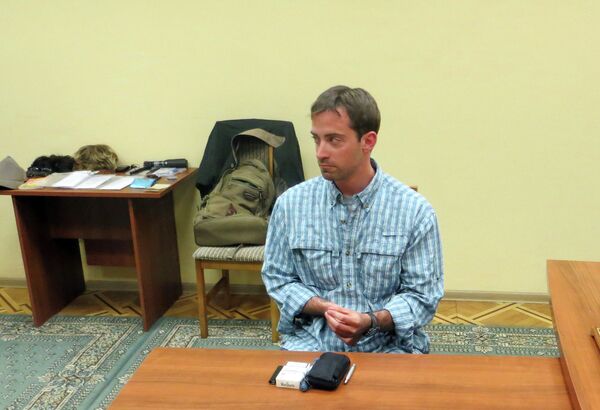WASHINGTON, May 14 (By Carl Schreck for RIA Novosti) – The alleged espionage arsenal that a purported American spy was carrying when he was caught Monday night in Moscow – including a compass and a map of the Russian capital – looks decidedly old-school in the age of iPhones and GPS navigators.
But when it comes to spy tradecraft, newer isn’t necessarily better, a veteran clandestine services officer with the US Central Intelligence Agency (CIA) told RIA Novosti on Tuesday.
“Just as espionage itself is very old, many of the tradecraft methods for espionage are still valid,” said Peter Earnest, who operated intelligence collection and covert operations in Europe and the Middle East during a 35-year career with the CIA.
“Cell phones and text messages can be hacked,” Earnest added. “By resorting to written messages and dead-drop sites, you may be ensuring the intelligence service and perhaps the agent a level of security that trying to talk on the phone or something else doesn’t.”
Russian security officers detained a US diplomat Monday that they identified as Ryan Christopher Fogle and accused him of being an undercover CIA operative who tried to recruit a Russian agent.
In addition to the map and compass, photographs released by Russia’s Federal Security Service (FSB) suggest Fogle was carrying a cache of tradecraft tools that look like props out of a Hollywood Cold War thriller: two floppy wigs, one light and one dark; three pairs of glasses; a folding knife; stacks of cash; and an outdated cell phone.
Much remains murky about the incident, and some former US counterintelligence officials and security experts expressed skepticism about the array of accoutrements Fogle was allegedly apprehended with. These included a letter purporting to promise up to $1 million a year in exchange for “helpful information” sent to a Gmail account.
“I suspect that this kit is little more than a plant by the Russians to enhance the story of an American caught attempting to recruit Russian citizens to spy on Russia,” Eric O’Neill, a former counterintelligence official with the US Federal Bureau of Investigation (FBI), wrote on his website Monday.
“I also don’t see the point in carrying all these items if Fogle’s purpose was to provide a letter to his potential agent asking him or her to set up a Google account to receive further instructions,” added O’Neill, who played a key role in the 2001 conviction of FBI agent Robert Hanssen on charges of spying for the Soviet Union and Russia.
Earnest said, however, that while “we have no idea what the circumstances of this case are,” the detained diplomat’s purported possessions do not look incongruous for a modern-day spy. The wigs and glasses, in particular, can be quite useful in the service of subterfuge, he told RIA Novosti.
“If I’m meeting you in a car late at night, and we’re driving down a poorly lit street, they may have no idea who I am, though they might recognize me in broad daylight,” said Earnest, founding executive director of the International Spy Museum in Washington.
Mark Galeotti, an expert on Russian security services at New York University, concurred that traditional tradecraft still has a role in contemporary espionage.
“There’s always a place for old-school,” Galeotti told RIA Novosti on Monday. “Sometimes you really do need to change suits, at which point you might throw on a wig.”
The ring of alleged Russian sleeper agents, including socialite Anna Chapman, arrested by the FBI in 2010 were caught on camera employing many of the spy communication techniques made famous in Cold War films and literature.
The tradecraft tactics the agents used included so-called “dead drops” of objects at secret locations and so-called “brush passes,” in which one conspirator surreptitiously passes something to another as they walk past one another.
“Their methods in contacting case officers were very traditional, even though they had laptops and other means,” Earnest told RIA Novosti. “I think one thing that struck people after that case was why it wasn’t more sophisticated.”
Steganography – the practice of sending secret messages – is possible via computers as well, but this practice can be a double-edged sword, Earnest noted. The alleged Russian sleeper agents, for example, embedded encoded messages about cash exchanges and other meetings in images that were uncovered by US investigators after they were posted on the Internet, according to the FBI.
“You can send things using steganography with a computer … but you still have the risk that it will be broken,” Earnest said.
Galeotti said the letter divulged by the FSB, in which Fogle purportedly offered the Russian officer money in exchange for cooperation, would be a remarkable breach of tradecraft.
“If he genuinely did that, then he was tremendously stupid,” Galeotti told RIA Novosti.
Earnest, however, said such a letter could be a plausible method of making arrangements with a contact.
“We’ve all seen examples of communications or letters used by intelligence services,” Earnest said. “In that sense, I don’t think it sounds like it’s that off-the-wall.”
The inclusion of the compass strained credulity a bit more, said Earnest, who called the instrument’s emergence in the incident “a puzzler.” He added, however, that a compass could conceivably help give an intelligence agent “trying to find his way around” a “developed sense of direction.”
Galeotti found it harder to believe: “Come on, who uses a compass these days?”


